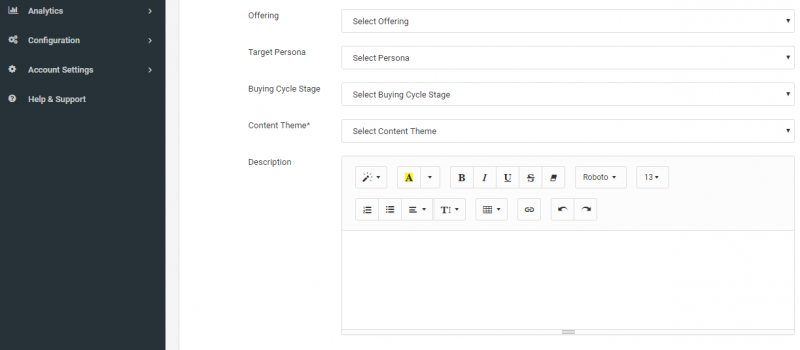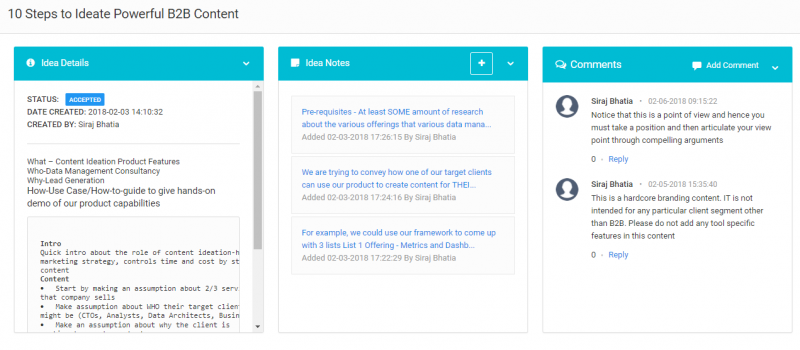By Ekaterina Volkwaska | February 11th, 2018
Precision in content ideation is crucial for successful B2B marketing. Well-vetted ideas ensure practical and efficient outcomes, aligning with goals and constraints. Relying on individual writers’ brilliance alone isn’t scalable; formal ideation methods are essential for effective content marketing.
Around 47% of B2B buyers consume three to five pieces of content prior to engaging with a salesperson; this data further points to the critical role that well-planned and targeted content plays in guiding potential buyers through their decision-making process, emphasizing the importance of a strategic approach to content ideation in B2B marketing efforts.
Four Building Blocks of the Content Ideation Process?
Every content ideation process starts with a solid strategy. For any strategy to truly succeed, it must address essential questions like What, Why, Who, How, Where, and When. Mastering these four blocks is crucial, and understanding why content ideation deserves a dedicated role is key to this mastery.
Let us show you how this simple yet effective approach can serve as the cornerstone for a robust framework for generating impactful content ideas:
What Why Who and How?
| What | Looking for an idea? Great! But what’s the focus? It’s crucial to align with your portfolio. In the B2B space, having a clear set of offerings is essential. If you don’t have one, work with your leadership to define your offerings matrix first. |
| Why | Having a list of your offerings is a good start, but clarify your promotion goals. Are you aiming to build awareness for a product or target prospects already interested in your offering? Understanding your goal will shape the content themes you use. |
| Who | With the What, Why, and Who in place, consider how to communicate with your audience. Your choice of content themes—such as use cases, product demos, how-to guides, and best practices—should align with the purpose and value of your content. Use these themes strategically to match your content goals. |
| How | With the What, Why, and Who in place, consider how to communicate with your audience. Your choice of content themes—such as use cases, product demos, how-to guides, and best practices—should align with the purpose and value of your content. Use these themes strategically to match your content goals. |
Once you complete the brainstorming on the above points, you should be good to generate a large volume of highly focused content ideas that make sense within your specific business context. Let us illustrate this using the example of a hypothetical company that provides IT services in the data management space. Here is what the elaborated matrix looks like for this company
Applying the Ideation framework to generate content ideas for an IT services company
| What (The list of offerings that the company sells) | 1. Big Data Engineering services 2. Data Analytics and Statistical data analysis services 3. Dashboards and Reporting 4. Enterprise Data Architecture and Data Strategy |
| Why (Content promotion objectives) | 1. Lead Generation 2. Branding |
| Who (For each offering, who is the target audience) | 1. Big Data Engineering Services – CTOs 2. Data Analytics Services – Business unit heads (Finance, Procurement, Marketing, etc.) 3. Dashboards and Reporting – Business unit heads 4. Enterprise Data Architecture Services – CTOs, Senior Data Architects |
| How (Content themes for communication) | 1. Use Cases 2. Framework Guides 3. Best practices Guides |
Create Distinct Idea Lists with This Matrix—Syptus Shows You How
| Idea List 1 | Idea List 2 | Idea List 3 | |
|---|---|---|---|
| What | Big Data Engineering Solutions | Data Analytics Services | Dashboards and Reporting |
| Why | Lead Gen | Lead Gen | Branding |
| Who | CTOs | Marketing Heads | Business Analysts |
| How | Use Cases | Best Practices Guides | Free Templates |
| Content Ideas | 1. Use cases for Building Custom Web Analytics Tools using Big data technology stack 2. Use cases for Spark-based systems in real-time marketing analytics | 1. Best practices in creating modelling datasets for marketing attribution 2. Best practices in working with outliers in building customer analytics datasets 3. Best practices in creating unified visitor analytics profiles for cross channel customer experience optimization | 1. Sample scorecard for measuring marketing performance in multichannel retail 2. Tableau Cheatsheets for implementing advanced calculated metrics |
Building on the previous ideas, you could theoretically create 96 combinations of content by mixing the “what,” “why,” “who,” and “how” factors. However, only some combinations will make sense for your business, and even if they did, prioritizing them would be a massive task. Consider factors like potential reach, communication channels, targeting data, writer availability, and the time your in-house experts can dedicate.
This is where the Content Marketing Strategist becomes essential. No matter which combinations you choose or how you prioritize them, you now have a strong framework for generating content ideas that align with your marketing objectives.
Software to the rescue-The Syptus Content Ideas Builder Tool
Managing the content ideation process—creating lists, gathering ideas from team members, prioritizing them, and handling approvals—can be overwhelming and time-consuming. These tasks often consume valuable time that could be better spent on brainstorming and developing lists that align with your business objectives.
- Simplifies content ideation and management.
- Reduces time spent on manual tasks and approvals.
- Frees up time for strategic brainstorming and planning.
The Syptus Idea Builder Tool addresses these challenges by providing a streamlined approach. It allows users to set up lists using meta-data overlays such as who, why, what, and how. Additionally, custom tags let you further refine ideas based on criteria like department, brand, geography, and team.
- Create lists with key meta-data overlays: who, why, what, how.
- Enhance lists with custom tags for department, brand, geo, and team.

Powerful Collaboration and Integration
The Syptus Content Ideas Builder Tool includes robust collaboration features, enabling teams to finalize the content blueprint before it moves into production. It integrates seamlessly with third-party tools like Feedly and Evernote, allowing team members to add notes directly to ideas within the tool.
- Collaboration features for team agreement on content blueprints.
- Integration with Feedly and Evernote for easy note-taking.

Additionally, the tool is fully integrated with the Syptus platform, facilitating the smooth conversion of ideas into asset requests and their subsequent promotion across selected media channels.
- Seamless conversion of ideas into asset requests.
- Efficient promotion of content through media channels.
Final Words:
For medium-to-large content marketing teams, developing effective processes for content ideation and then deploying the right tools to streamline the ongoing management of these processes is a critical enabler for long-term content marketing success. The right blend of content marketing art, technology, and practical application skills can easily set you up for incredibly effective and efficient delivery in the long run.





